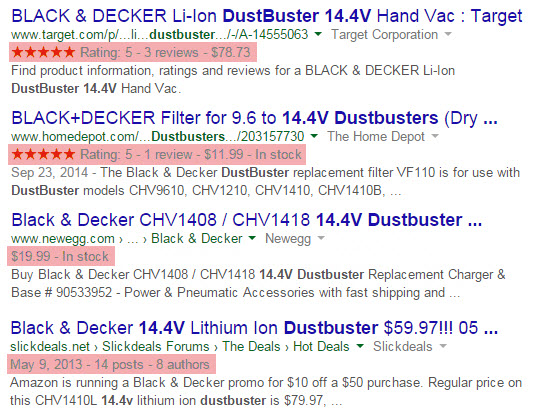This is the seventh, and final, installment of my “SEO 201″ series, following:
- “Part 1: Technical Rules”;
- “Part 2: Crawling and Indexing Barriers”;
- “Part 3: Enabling Search-engine Spiders”;
- “Part 4: Architecture Is Key”;
- “Part 5: Evaluating Ecommerce Platforms”;
- “Part 6: Redesigns Impact Search Traffic.”
Do you ever wonder how some ecommerce sites get yellow stars, prices, or thumbnails in their search result listings? That’s structured data at work.
Structured data sounds a bit off-putting, but it’s simply a way of tagging the data in your web pages in a way that search engines can easily understand. These data elements can be anything from pricing and availability to breadcrumbs and video.
Search engines can opt to use these easily identifiable structured data types in their search results as rich snippets, search result listings that have been embellished with additional information. For example, a search in Google for “dustbuster 14.4v” returns these sample results containing rich snippets — I’ve added the pink background.

Samples of rich snippets in Google search results.
The results that contain rich snippets, especially bright yellow ratings stars, draw the eye to potentially increase click through to the site. They also offer additional information directly in the search result, enabling the customer to make more informed purchase decisions before leaving the search result page.
Rich snippets appear on pages dedicated to a single entity — a product, a forum post, an event, a music album — and as a result are only available for ecommerce sites on product detail or forum pages. Because they contain multiple products or topics, category pages aren’t eligible for rich snippets. Only product detail pages are supported at this point, and only when the product mentioned is for sale directly on that page.
How to Implement Structured Data?
Structured data is a code-level element, requiring changes to the templates your platform uses to display your site. Consequently, you’ll need the assistance of a developer to make the changes. However, implementing the tags that identify structured data types is just a matter of wrapping another tag around the data areas that already exists in your templates.
The major search engines have collaborated on structured data and developed a set of specifications at Schema.org that outline the supported data types and how to implement them.
For example, Google is displaying the following structured data types found on Target’s product detail page: Price, AggregateRating, and Availability. The bit of code that identifies the price as a Price data type is highlighted below.

Target’s product page with Price structured data highlighted.
Target didn’t need to generate any new content to enable these rich snippets because pricing, ratings, and availability were already integrated into the product detail page template. Target’s developers just needed to include the small pieces of code to identify those data elements as Price, AggregateRating, and Availability data types.
Arguments Against Structured Data
I often hear arguments against implementing structured data on the basis that it enables easier theft of content: “Scrapers will be able to steal my content more easily.”
Scrapers can already very easily steal your content without structured data types. Free, readily available tools enable anyone to crawl a site and collect content. The scrapers can look at your product template, enter the HTML tags you use already into their scraper application and export a CSV file with the product names and descriptions of every product you sell.
Google itself is the other named culprit in this argument. Its Knowledge Graph is a voracious user of data with the goal of answering searchers questions directly on the search results page. Some feel that bubbling the answer up from the page that actually gives the answer to display it directly on the search results page essentially steals the click from the site that provided the data.
This is typically only a major issue if your site is a deep source of informational content like Wikipedia. For example, see the Google search result below for “elephant.” The highlighted link is Google’s attribution that the information came from Wikipedia.

Google search result for “elephants.”
Search phrases with ecommerce intent do not typically trigger the appearance of the Knowledge Graph and its show-stealing visual elements. And the broad search phrases that do trigger Knowledge Graph displays are not likely to incorporate ecommerce data in the display.
Since structured data really doesn’t give scrapers or Google’s Knowledge Graph a leg up, and can benefit your search-engine-optimization performance, there are few reasons not to implement it.
You could argue that by listing the price on the search result itself, the searcher may choose not to click your listing. If this is the case, either your pricing isn’t competitive or the searcher was really only comparing prices anyway. Either way, if the searcher had clicked through to your product page, the click from search results would have resulted in a bounce back out of the site when she viewed that bit of information. Rich snippets won’t lose you the sale in this case even if you lose the click, because it was a sale you never had.
The only exception I can see to this is if your site does an exceptional job of cross selling. In that case, you may actually keep some of the quick research clicks that intended to bounce out.
Another instance in which rich snippets could have a negative impact is when the data likely to be displayed in the rich snippet is unfavorable. For example, if your prices are markedly higher than the competition or your reviews markedly lower, then rich snippets would not be beneficial.
Will rich snippets generated from structured data solve your SEO performance woes? Almost certainly not. But they are a way to potentially get a leg up on competitors who don’t use this tactic. Additional positive visibility in search results is always good.
Google is quick to point out that rich snippets are one of its many experiments. Marking your code up doesn’t guarantee that the search engines will use that structured data in rich snippets. In addition, search engines could discontinue the program at any time.
Nonetheless, Google does offer a couple of tools to assist with the creation of structured data and testing of rich snippets:





